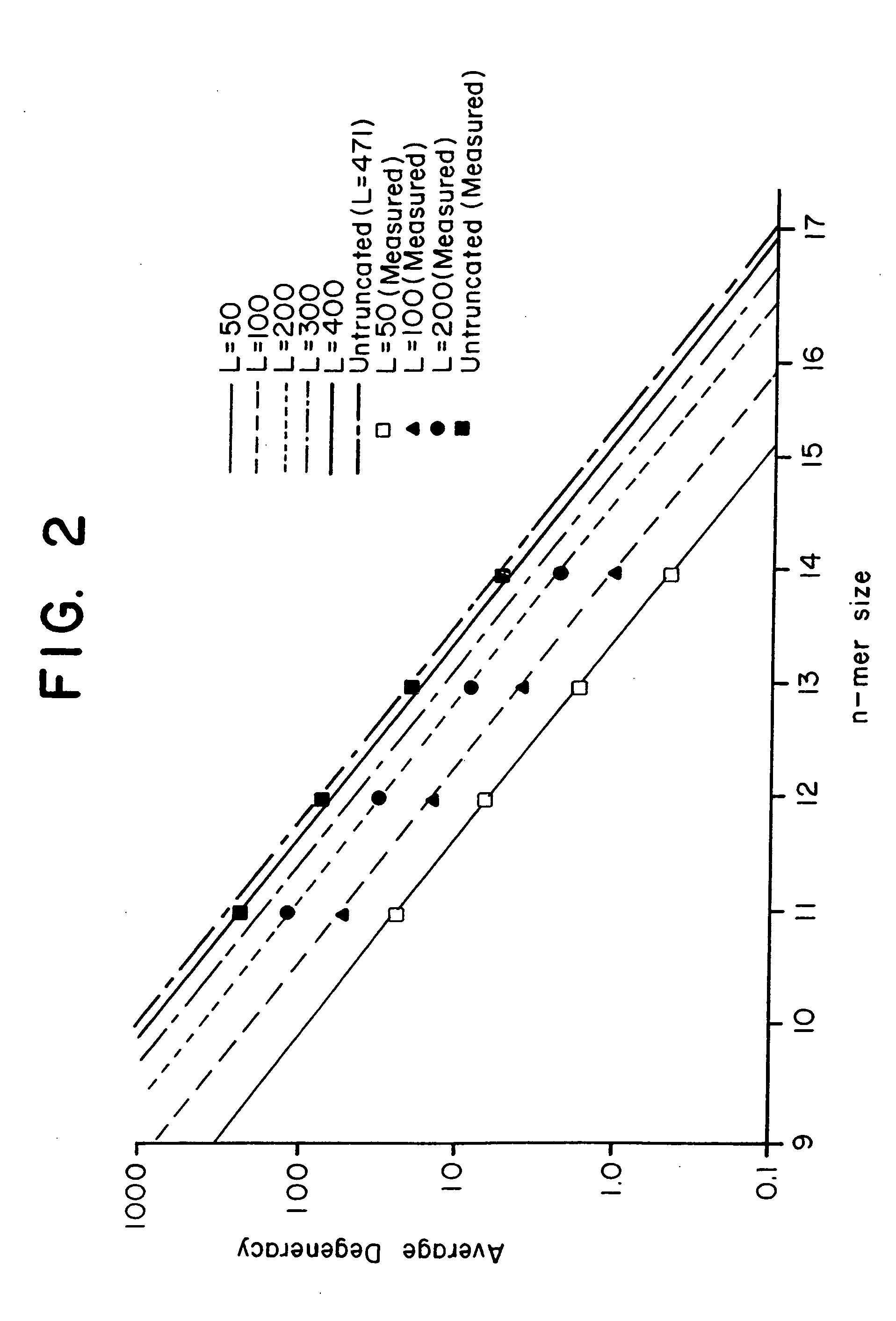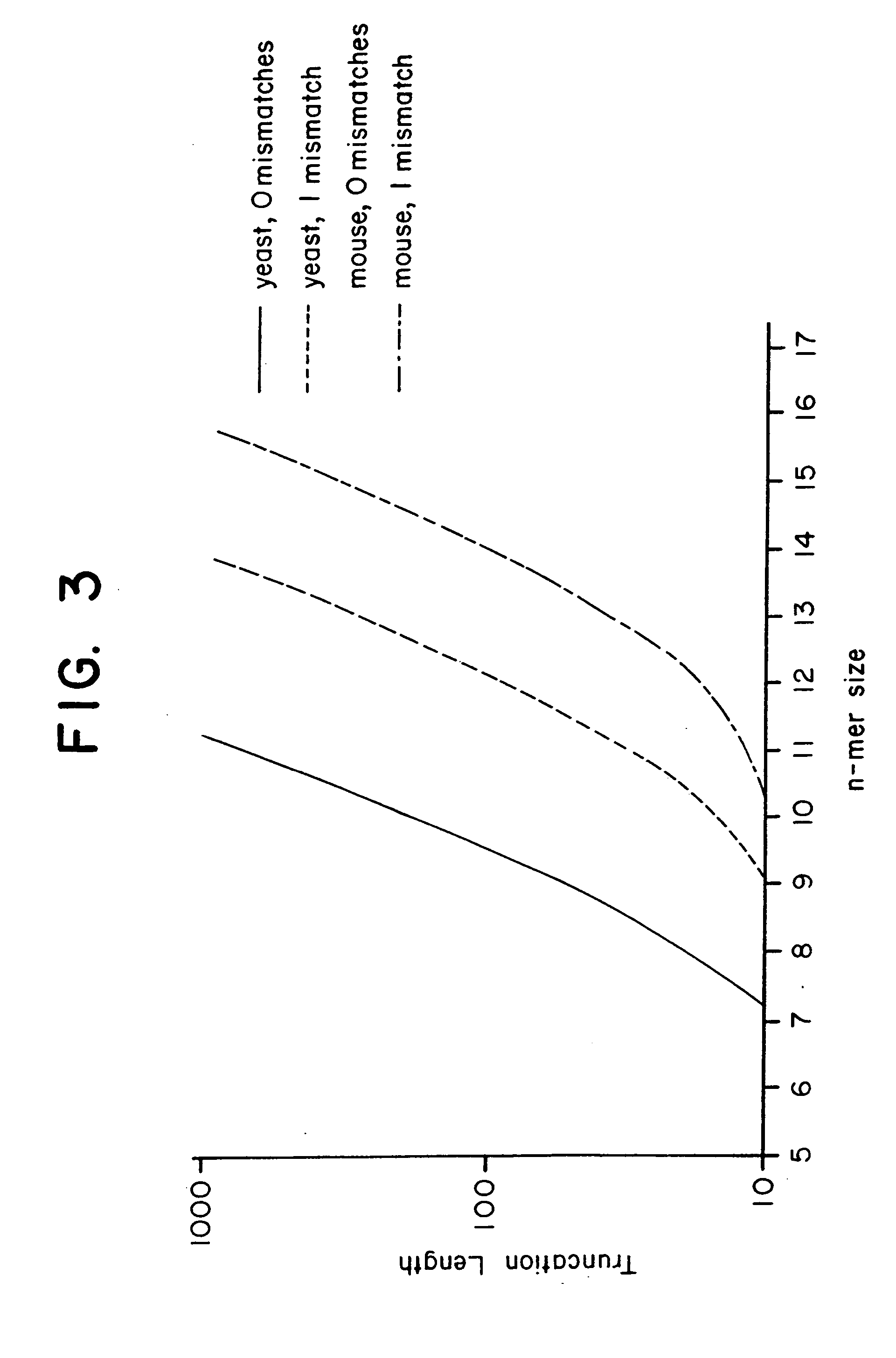Combinational array for nucleic acid analysis
a nucleic acid analysis and array technology, applied in the field of combinatorial arrays for nucleic acid analysis, can solve the problems of time-consuming, labor-intensive and expensive process, and the practical limit of the number of genes that can be incorporated into such nucleic acid microarrays is 10,000-30,000 genes per square inch, and the approach requires a relatively large overhead
- Summary
- Abstract
- Description
- Claims
- Application Information
AI Technical Summary
Benefits of technology
Problems solved by technology
Method used
Image
Examples
example 1
6.1. Example 1
Genetic Analysis with a Universal Array
[0078] This Example describes the theoretical correlation between the optical signals generated during hybridization experiments, to gene expression levels in the mouse and yeast genome.
[0079] Notation. The genome is represented as a set, G, and its constituent nucleic acid sequences is represented as G={g1, g2, . . . , gj, . . . , gNg}. Ng is the total number of genes. Each sequence called here a “gene” corresponds to one mRNA sequence which may be found in the cell. (The mRNA is transcribed from individual genes in the DNA, and serves as the template from which the cell makes proteins. The amount of each particular mRNA sequence in the cell reflects the expression level of the corresponding gene.) At any given instant (and under a given set of experimental conditions), the expression level of the genes in a sample can be represented as a single Ng-dimensional vector in expression-level-space (ε),
E=(E1,E2, . . . , Ej, . . . , ...
example 2
6.2. Example 2
Algorithm for Determination of Gene Expression Patterns
[0098] In this Example an algorithm is presented for construction of the projector, P, (described in Example 1), for reducing the dimensionality of the space of oligonucleotides O(N). The algorithm is designed to find a projector which results in a nearly diagonal form for H if H is sufficiently sparse.
[0099] Definitions. In preferred embodiments, the following quantities are used in connection with the algorithm. The quantities are, in general, functions of the particular genome considered, as well as of the parameters n and m and any enzymatic treatment which alters the sequence space covered by the transcripts.
[0100] The quantity Degen(oj) refers to the degeneracy of the oligonucleotide oi. The terms “degeneracy” and “ambiguity”, as they are used herein, refer to the number of different genes to which a probe having an oligonucleotide sequence of length n may hybridize. Thus, the degeneracy of an oligonucleot...
example 3
6.3. Example 3
Probabilistic Degeneracy Model
[0126] This Example presents an analytical model to predict the average degeneracy for a specified genome with a particular oligonucleotide length, n. This model predicts the suitable value for n which can accommodate genomes ranging in size from a yeast to a mouse. The model is further extended to incorporate additional parameters arising from some potentially useful modifications to the hybridization procedure, such as length truncation mentioned earlier. By analyzing degeneracies for real genomic sequence data, the model is validated and its various extensions bear a very close correlation between measured and predicted values. Finally, the model is used to estimate the parameters that are suitable or required to achieve low average degeneracy for the yeast and mouse genome, and to demonstrate that these predictions are accurate.
[0127] Basic Model. In consideration of a single gene of length l it is assumed that the immobilized n-mers...
PUM
| Property | Measurement | Unit |
|---|---|---|
| Tm | aaaaa | aaaaa |
| Tm | aaaaa | aaaaa |
| Tm | aaaaa | aaaaa |
Abstract
Description
Claims
Application Information
 Login to View More
Login to View More - R&D
- Intellectual Property
- Life Sciences
- Materials
- Tech Scout
- Unparalleled Data Quality
- Higher Quality Content
- 60% Fewer Hallucinations
Browse by: Latest US Patents, China's latest patents, Technical Efficacy Thesaurus, Application Domain, Technology Topic, Popular Technical Reports.
© 2025 PatSnap. All rights reserved.Legal|Privacy policy|Modern Slavery Act Transparency Statement|Sitemap|About US| Contact US: help@patsnap.com



